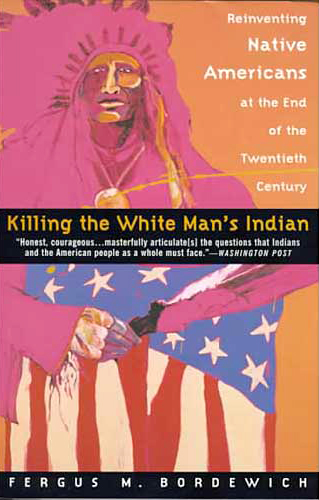
excerpts: Myths About Indians | Tribal Sovereignty | Indian Identity | Civil Rights | Economic Development | Tribal Gaming | Alcoholism | Sacred Lands
REVIEWS: New York Times | praise for white man's indian
Indian Sacred Lands
NO NATIVE LAND claim has remained longer without resolution, been fought with greater tenacity, or spawned more bitterness than the Sioux claim to the Black Hills. And nowhere have Indians challenged the white man’s ownership of the land more compellingly and with more potential consequence for its non-Indian occupants. They are the ultimate terra irridenta in the landscape of Native North America. “For Indians all over the United States, the Lakota have made these mountains the most visible and significant, as they are physically the largest, battleground in the struggle for land possession between the races on this continent,” the historian Donald Worster has written. In contrast to Mount Graham, whose ambiguous holiness is asserted by only a comparatively small number of Apaches, the “sacredness” of the Black Hills is an article of faith that is virtually unchallenged throughout the Sioux country. In a typical statement, a Pine Ridge tribal councilman by the name of Gerald Big Crow told the United Nations Working Group on Indigenous Populations, which in 1991 was considering a resolution condemning the the U.S. government’s “confiscation” of the Hills in the 1870s: “The taking of the sacred Black Hills was the same as taking our spiritual altar. It would have the same impact if all churches and synagogues were closed.”
On a prosaic plane, the Black Hills are a central pillar of South Dakota’s economy. Taken altogether, commercial activities in the Hills provide the state with $600 million in taxes annually, its third largest source of revenue. The vast strip-mined vistas around the town of Lead may be prototypes of environmental rape, but they are also evidence of the fabulous wealth that has been extracted from the Hills since the discovery of gold there by an expedition headed by General George Armstrong Custer, in 1874; by the mid-1990s, the Homestake Mine, the richest single mine in the United States, had alone produced nearly $18 billion in gold ore. Every year, millions of tourists, campers and hikers come to enjoy the thousands of acres of federally managed parkland and to visit the presidential shrine at Mount Rushmore, and the old frontier town of Deadwood, whose long economic decline was recently reversed when the state legislature legalized casino gambling there. Elsewhere, highways through the Hills sport lurid, interminable garlands of wax museums, miniature golf courses, reptile gardens, waterslides, dude ranches and ersatz frontier towns, as well as more singular tourist traps such as the “Home of the Talking Woodcarvings” and the “Flintstones Bedrock City” (“Yabba Dabba Do!” ubiquitous billboards crow).
There is, at the same time, in spite of the trashy development and the scarred slopes, something undeniably enigmatic about the Hills. Perhaps it is something in the way in which they seem to someone driving westward on Interstate 80 to erupt so unexpectedly from the otherwise featureless, coppery-green plain, or perhaps something in their interior topography of concealment and surprise: in the weird forests of unearthly landforms, the secluded pastures, the steep wooded vales made mysterious by the chiaroscuro of hard prairie light. Whatever its origins, it is a quality that lends itself to dreams and myth-making and to notions of the transcendental, to the idea that somewhere here humankind might truly, on some primeval afternoon, have sprung fullblown from its bowels.

